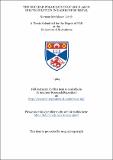Files in this item
The nuclear polarization of gold 198 in dilute solution in gadolinium metal
Item metadata
| dc.contributor.author | Leitch, Norman Mathieson | |
| dc.coverage.spatial | 113 p. | en_US |
| dc.date.accessioned | 2018-06-28T09:12:53Z | |
| dc.date.available | 2018-06-28T09:12:53Z | |
| dc.date.issued | 1964 | |
| dc.identifier.uri | https://hdl.handle.net/10023/14687 | |
| dc.description.abstract | In 1960, Samoilov, Sklyarevskii and Stepanovil reported a series of experiments on the nucles polarization of the nuclei of diamagnetic elements in dilute solution in magnetically saturated iron. These experiments were successful attempts to obtain nuclear polarization of the gamma-ray emitting nuclei of indium, antimony, and gold in dilute solution of iron. The specimens were cooled to about 0.03°K bt adiabatic demagnetization of a pill of a paramagnetic salt in thermal contact with them, and were magnetized to saturation. Nuclear orientation in the specimens was detected by anisotropy in the gamma-ray emission which was measured by two scintillation counters arranged parallel and perpendicular to the direction of magnetization of the specimens. They concluded that nuclear orientation was due to interaction of the nuclei with a strong internal magnetic field within the alloy, and from the anisotropy of the gamma-ray emission they determined the order of magnitudes of the magnetic fields at these nuclei. Effective magnetic fields of the order of 7x10⁵ gauss were estimated to act on the AU¹⁹⁸ nuclei in iron where the magnetic 3d shell is close to the surface of the atom. It was our intention to determine whether the deeply imbedded 4f electron shell of gadolinium could produce such large hyperfine field as would polarize the gold nuclei in a dilute alloy of gold in gadolinium. A series of experiments on the nuclear polarization of gold in gadolinium by the method of Samoilov are reported in this thesis. A review of the current state of the theory of internal magnetic fields in ferromagnetic materials is given in Chapter III. Much of the theoretical work reviewed here was published after the commencement of the work described in this thesis, and would certainly have suggested other experiments to be performed in this field, had it been published earlier. We intended also, as part of this series of experiments, to investigate the nuclear polarization of the nuclei of suitable gadolinium isotopes in pure gadolinium metal in order to have complementary estimates of the internal magnetic field in gadolinium. It was essential to use specimens in the form of thin discs for two reasons. It was desirable to decrease the demagnetization factor of the specimens, and it was necessary to have them circular in section so that the angular distribution of gamma radiation from a warm sample should be isotropic. The specimens were therefore punched from foils of the metal. Unfortunately, the bulk metal proved to be too brittle to roll them into thin sheets at room temperature. We did not have facilities for heat treatment of the metal, and delivery dates for samples in laminar form were too long to allow the work to be completed in time. We decided also to carry out an experiment on the nuclear orientation of Co⁶⁰ in a 50% Co-Ni alloy to test the apparatus and the results are given in chapter IX for interest and are compared with results obtained by other investigators. | en_US |
| dc.language.iso | en | en_US |
| dc.publisher | University of St Andrews | |
| dc.subject.lcc | QC721.L4 | |
| dc.subject.lcsh | Particles (Nuclear Physics) | en |
| dc.title | The nuclear polarization of gold 198 in dilute solution in gadolinium metal | en_US |
| dc.type | Thesis | en_US |
| dc.contributor.sponsor | North Atlantic Council | en_US |
| dc.type.qualificationlevel | Doctoral | en_US |
| dc.type.qualificationname | PhD Doctor of Philosophy | en_US |
| dc.publisher.institution | The University of St Andrews | en_US |
This item appears in the following Collection(s)
Items in the St Andrews Research Repository are protected by copyright, with all rights reserved, unless otherwise indicated.

